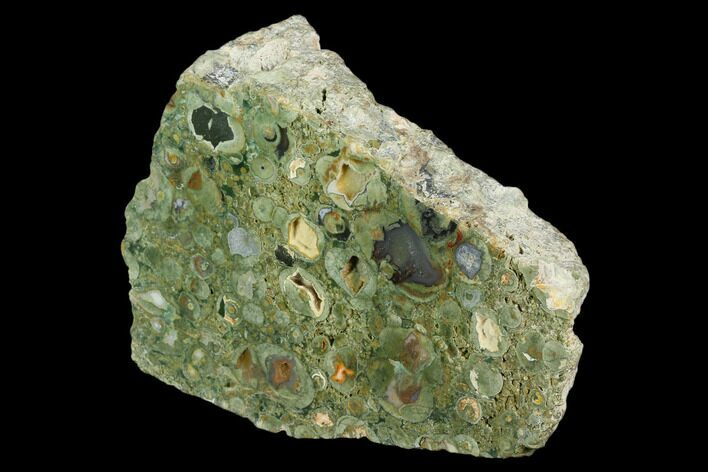This Specimen has been sold.
5.3" Polished Rainforest Jasper (Rhyolite) Section - Australia
This is a 5.3" wide polished Spherulitic Rhyolite section, collected from Mt. Hay, Queensland. Rhyolite (Rainforest Jasper) is group of extrusive igneous rocks, typically consisting of large-grained crystals such as feldspar or quartz dispersed in a fine-grained silicate rich rock. This type of rhyolite features pockets of agate.
About Rainforest Jasper
Rainforest jasper is the trade name for a very colorful type of rhyolite. It was formed when the long extinct Mount Hay volcano near Queensland, Australia erupted about 120 million years ago and subsequent silica-rich fluids deposited into gaps and cavities. Rainforest jasper gets its name because the mixture of green, red, yellow, brown, and orange colorations reminds people of a rainforest canopy. The spherical cavities (orbs) are lined with often lined with opal and tridymite, and filled with chalcedony.
A rhyolite is a volcanic rock characterized by a high silica content that forms from eruptions of granitic magmas. Granitic magmas are very dense, which causes them to cool more slowly: this allows more time for large crystalline structures called phenocrysts to form. These phenocrysts are typically silica-based minerals such as quartz and chalcedony, and are what give rainforest jasper its unique appearance.
Rainforest jasper is the trade name for a very colorful type of rhyolite. It was formed when the long extinct Mount Hay volcano near Queensland, Australia erupted about 120 million years ago and subsequent silica-rich fluids deposited into gaps and cavities. Rainforest jasper gets its name because the mixture of green, red, yellow, brown, and orange colorations reminds people of a rainforest canopy. The spherical cavities (orbs) are lined with often lined with opal and tridymite, and filled with chalcedony.
A rhyolite is a volcanic rock characterized by a high silica content that forms from eruptions of granitic magmas. Granitic magmas are very dense, which causes them to cool more slowly: this allows more time for large crystalline structures called phenocrysts to form. These phenocrysts are typically silica-based minerals such as quartz and chalcedony, and are what give rainforest jasper its unique appearance.
About Jasper
Jasper is a term that can be applied to an opaque variety of chalcedony. The opaqueness is due to a higher concentration of impurities mixed with silica/quartz compared to other varieties of silica, such as quartz or agates. Like agate it may form in a wide variety of colors, and is often multi-colored. In most cases, jasper forms when silica-rich fluids permeate throughout a soft sediment or volcanic debris deposit. The fluids then crystallize around the particles/impurities, resulting in a cementation process. Most often, the impurities present determine the coloration of the deposit following solidification, but other factors can play a role in the color of what is now considered a jasper.
Jasper is a term that can be applied to an opaque variety of chalcedony. The opaqueness is due to a higher concentration of impurities mixed with silica/quartz compared to other varieties of silica, such as quartz or agates. Like agate it may form in a wide variety of colors, and is often multi-colored. In most cases, jasper forms when silica-rich fluids permeate throughout a soft sediment or volcanic debris deposit. The fluids then crystallize around the particles/impurities, resulting in a cementation process. Most often, the impurities present determine the coloration of the deposit following solidification, but other factors can play a role in the color of what is now considered a jasper.
About Agate
Agate is a variety of microcrystalline quartz (chalcedony) that displays translucence and, in some cases, banding. Agate primarily forms when silica-rich fluids fill pockets within rocks and/or fossils, depositing the silica along the walls of the rock. This process can result in banding patterns, as the compositions and impurities of these depositing fluids change over time. These banding patterns can either form as flat layers, creating linear patterns known as waterline agate, or as rounded layers, forming more common ring-like patterns. These patterns depend on the surfaces available for deposition.
Agate is a variety of microcrystalline quartz (chalcedony) that displays translucence and, in some cases, banding. Agate primarily forms when silica-rich fluids fill pockets within rocks and/or fossils, depositing the silica along the walls of the rock. This process can result in banding patterns, as the compositions and impurities of these depositing fluids change over time. These banding patterns can either form as flat layers, creating linear patterns known as waterline agate, or as rounded layers, forming more common ring-like patterns. These patterns depend on the surfaces available for deposition.
SPECIES
Rhyolite
LOCATION
Mt. Hay, Queensland, Australia
SIZE
5.3 x 3.8", up to 1.85" thick
CATEGORY
SUB CATEGORY
ITEM
#130413
 Reviews
Reviews














